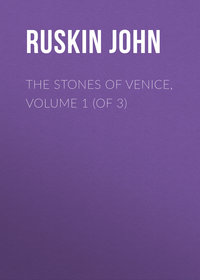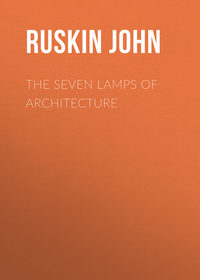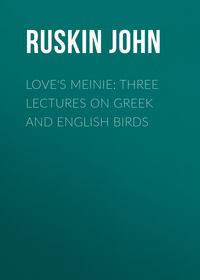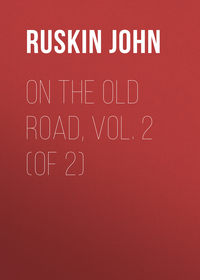 полная версия
полная версияThe Eagle's Nest
It is true that to do anything perfectly well is about equally difficult; and I suppose that in a chariot race, a tournament, or a modern game at cricket, the manual art of the most highly-trained men would be almost equally fine; still, practically, in Gothic chivalry, the knight trusted more to his weight and less to his skill than a Greek did; nor could a horse’s pace under armour ever render precision of aim so difficult as at unarmed speed.
232. Another great difference of a parallel kind exists in the knight’s body armour. A Greek never hopes to turn a lance by his cuirass, nor to be invulnerable except by enchantment, in his body-armour, because he will not have it cumbrous enough to impede his movements; but he makes his shield, if possible, strong enough to stop a lance, and carries it as he would a piece of wall: a Gothic knight, on the contrary, endeavoured to make his coat armour invulnerable, and carried the shield merely to ward thrusts on the left side, never large enough to encumber the arm that held the reins. All fine design in Gothic heraldry is founded, therefore, on the form of a short, but pointed shield, convex enough to throw the point of a spear aside easily; a form roughly extending from the beginning of the twelfth to the middle of the fifteenth century, but of which the most beautiful types are towards the end of the thirteenth.
233. The difference in method of device between the Gothic and classic shields resulted partly from this essential difference in form. The pointed shield, having definitely two sides, like a pointed arch, and a determined position, naturally suggested an arrangement of bearings definitely on one side or the other, or above, or below the centre, while the Greek shield had its boss, or its main bearing, in the centre always, with subordinate decoration round. Farther, the Gothic fineness of colour-instinct seized at once on this division of parts as an opportunity for inlaying or counterchanging colours; and finally, the respect for race, carried out by registry of the remotest branches of noble families, compelled the Gothic heralds of later times to use these methods of dividing or quartering in continually redoubled complexity.
234. Essentially, therefore, as distinguished from the classic shield, the Gothic one is particoloured beneath its definite bearings, or rather, bi-coloured; for the tinctures are never more than two in the main design of them; and the specific methods of arrangement of these two masses of colour have deeper and more ancient heraldic significance than, with few exceptions, their superimposed bearings. I have arranged the twelve principal ones12 in the 7th of your rudimentary exercises, and they will be entirely fixed in your minds by once drawing it.
“They have also the title of honourable ordinaries in that the court armour is much honoured thereby.“ The French call them “pièces honorables.”
235. Observe respecting them.
1. The Chiefe; a bar of colour across the upper part of the shield, signifies authority or chief-dom, as the source of all order, power, and peace.
2. The cross, as an ordinary, distinguished from the cross as a bearing, consists simply of two bars dividing the shield into four quarters; and, I believe, that it does not in this form stand properly as a symbol of Christian faith, but only as one of Christian patience and fortitude. The cross as a symbol of faith is terminated within the field.
3. The Fesse, a horizontal bar across the middle of the shield, represents the knight’s girdle, or anything that binds and secures, or continues. The word is a corruption of fascia. Sir Francis Drake received for arms from Queen Elizabeth a Fesse waved between two pole-stars, where it stands for the waved surface of the sea, and partly, also, to signify that Sir Francis put a girdle round the earth; and the family of Drummond carries three diminutive Fesses, or bars, waved, because their ancestor brought Queen Margaret safe through many storms.
4. The Bend, an oblique bar descending from right to left of the holder of the shield, represents the sword belt. The Latin balteus and balteum are, I believe, the origin of the word. They become bendellus and bendellum; then bandeau and bande. Benda is the word used for the riband round the neck of St. Etheldreda, in the account of her death quoted by Du Cange. I believe, also, the fesse stands often for the cross-bar of the castle gate, and the bend for its very useful diagonal bar: this is only a conjecture, but I believe as likely to be true as the idea, certainly admitted in heraldry, that the bend sometimes stands for a scaling ladder: so also the next four most important ordinaries have all an architectural significance.
5. The Pale, an upright bar dividing the shield in half, is simply an upright piece of timber in a palisade. It signifies either defence or enclosure.
6. The Pile, a wedge-shaped space of colour with the point downwards, represents what we still call a pile; a piece of timber driven into moist ground to secure the foundation of any building.
7. The Canton, a square space of colour in either of the upper corners of the shield, signifies the corner-stone of a building. The origin and various use of this word are very interesting. The Greek κανθός, used by Aristotle for the corner of the eyes, becomes canto, and then cantonus. The French coin (corner), is usually derived from the Latin cuneus; but I have no doubt it is one corruption of canton: the mediæval-Latin cantonus is either an angle or recess, or a four-square corner-stone. The heraldic canton is the corner-stone of a building, and the French cantonnier is a road-mender, because the essential thing in repairing a road is to get its corner or edge firm.
8. The Chevron, a band bent at an angle (properly a right angle), with its point upwards, represents the gable or roof of a house. Thus the four last-named ordinaries represent the four essentials of a fixed habitation: the pale, its enclosure within a given space of ground; the pile, its foundation; the canton, its wall, and the chevron its roof.
9. The Orle, a narrow band following the outline of the shield midway between its edge and centre, is a more definite expression of enclosure or fortification by moat or rampart. The relations of this word, no less than that of the canton, are singular, and worth remembering. Du Cange quotes under it an order of the municipality of Piacenza, that always, in the custom-house where the salt-tax was taken, “a great orled disk” should be kept; “dischus magnus orlatus,” i.e., a large plate, with a rim, in which every day fresh salt should be placed. Then note that the word disk is used in the Middle Ages, either for a plate, or a table, (the “holy disk” is the patina of the sacrament), but most generally for a table, whence you get the old German disch; our dish, the French disner, diner; and our dinner. The disk cut out into a ring becomes a quoit, which is the simplest form of orle. The word ‘orle’ itself comes, I believe, from ora, in old Latin, which took a diminutive, orula; or perhaps the ‘l’ was put in merely to distinguish, to the ear, a margined thing, ‘orlatus,’ from a gilded thing, ‘auratus.’ It stands for the hem of a robe, or the fillet of a crown, as well as for any margin; and it is given as an ordinary to such as have afforded protection and defence, because it defends what is within it. Reduced to a narrow band, it becomes a ‘Tressure.’ If you have a sovereign of 1860 to 1870 in your pocket, and look at the right hand upper corner of the Queen’s arms, you will see the Scottish Lion within the tressure decorated with fleur-de-lys, which Scotland bears in memory of her treaty with Charlemagne.
10. The Gyron, a triangular space of colour with its point in the centre of the shield, derives its name from the old Latin gyro, a fold, “pars vestis quâ laxior fit, et in superiori parte contracta, in largiorem formam in imo se explicat.“ The heraldic ‘gyron,’ however, also has a collateral reference to, and root in, the word ‘gremium,’ bosom or lap; and it signifies properly the chief fold or fall of the dress either over the bosom, or between the knees; and has whatever symbolic expression may be attributed to that fold, as a sign of kindness or protection. The influence of the lines taken by softly falling drapery in giving gentleness to the action of figures was always felt by the Gothic artists as one of the chief elements of design; and the two constantly repeated figures of Christ holding souls in the ‘gremium’ of His robe, and of the Madonna casting hers over suppliants, gave an inevitably recognised association to them.
11. The Flasque, a space of colour terminated by a curved line on each flank of the shield, derives its name from the Latin flecto, and is the bearing of honour given for successful embassy. It must be counted among the ordinaries, but is of rare occurrence in what groups of authentic bearings I have examined.
12. The Saltire, from salir, represents the securest form of machine for mounting walls; it has partly the same significance as the ladder of the Scaligers, but, being properly an ordinary, and not a bearing, has the wider general meaning of successful ascent, not that of mere local attack. As a bearing, it is the St. Andrew’s Cross.
236. These twelve forms of ordinary then, or first colour divisions of the shield, represent symbolically the establishment, defence, and exaltation of the Knight’s house by his Christian courage; and are in this symbolism, different from all other military bearings. They are throughout essentially founded on the “quartering” or division of the field into four spaces by the sign of the Cross: and the history of the chivalry of Europe is absolutely that of the connection of domestic honour with Christian faith, and of the exaltation of these two sentiments into the highest enthusiasm by cultivated imagination.
The means of this culture by the finer arts; the errors, or falls, of the enthusiasm so excited; its extinction by avarice, pride, and lust, in the period of the (so called) Renaissance, and the possibility of a true Renaissance, or Restoration, of courage and pure hope to Christian men in their homes and industries, must form the general subject of the study into which I have henceforth to lead you. In a future course of lectures it will be my endeavour to show you, in the elementary forms of Christian architecture, the evidence of such mental development and decline in Europe from the tenth to the seventeenth century; but remember that my power or any one else’s, to show you truths of this kind, must depend entirely on the degree of sympathy you have in yourselves with what is decorous and generous. I use both these words advisedly, and distinctively, for every high quality of art consists either in some expression of what is decent,—becoming,—or disciplined in character, or of what is bright and generous in the forces of human life.
I need not say that I fear no want of such sympathy in you; yet the circumstances in which you are placed are in many respects adverse to it.
237. I find, on returning to the University after a period of thirty years, the scope of its teaching greatly extended, the zeal of its masters certainly undiminished; and, as far as I can judge, the feeling of the younger members of the University better, and their readiness to comply with all sound advice, greater, than in my time. What scandals there have been among us, I think have been in great part accidental, and consequent chiefly on the intense need for excitement of some trivial kind, which is provoked by our restless and competitive work. In temper, in general amenability to right guidance, and in their sense of the advantages open to them, more may now be hoped than ever yet from the students of Oxford—one thing only I find wanting to them altogether—distinctness of aim.
238. In their new schools of science they learn the power of machinery and of physical elements, but not that of the soul; I am afraid, in our new schools of liberal religion they learn rather to doubt their own faiths than to look with patience or respect on those of others; and in our new schools of policy, to efface the canons of the past, without having formed any distinct conception of those which must regulate the institutions of the future.
239. It is therefore a matter of very deep rejoicing to me that, in bringing before your examination the best forms of English art, I am necessarily leading you to take interest in the history of your country at the time when, so to speak, it became England. You see how, in every college which is now extending or renewing its buildings, the adopted style is approximately that of the thirteenth century;—it being felt, and rightly felt, by a continually-extending instinct, that only then the national mind had unimpaired power of ideal conception. Whatever else we may have advanced in, there is no dispute that, in the great arts, we have steadily, since that thirteenth century, declined: and I have, therefore, since accepting this professorship, partly again taken up my abandoned idea of writing the story of that century, at least in England; of writing it, or, at all events, collecting it, with the help of my pupils, if they care to help me. By myself, I can do nothing; yet I should not ask them to help me if I were not certain that at this crisis of our national existence the fixing the minds of young and old upon the customs and conception of chivalry is the best of all moral education. One thing I solemnly desire to see all children taught—obedience; and one to all persons entering into life—the power of unselfish admiration.
240. The incident which I have related in my fourth lecture on sculpture, seen by me last year on the bridge of Wallingford, is a sufficient example of the courtesies in which we are now bringing up our peasant children. Do you think that any science or art we can teach them will make them happy under such conditions? Nay, in what courtesy or in what affection are we even now carefully training ourselves;—above all, in what form of duty or reverence to those to whom we owe all our power of understanding even what duty or reverence means? I warned you in my former lecture against the base curiosity of seeking for the origin of life in the dust; in earth instead of heaven: how much more must I warn you against forgetting the true origin of the life that is in your own souls, of that good which you have heard with your ears, and your fathers have told you. You buy the picture of the Virgin as furniture for your rooms; but you despise the religion, and you reject the memory, of those who have taught you to love the aspect of whatsoever things and creatures are good and pure: and too many of you, entering into life, are ready to think, to feel, to act, as the men bid you who are incapable of worship, as they are of creation;—whose power is only in destruction: whose gladness only in disdain; whose glorying is in their shame. You know well, I should think, by this time, that I am not one to seek to conceal from you any truth of nature, or superstitiously decorate for you any form of faith; but I trust deeply—(and I will strive, for my poor part, wholly, so to help you in steadfastness of heart)—that you, the children of the Christian chivalry which was led in England by the Lion-Heart, and in France by Roland, and in Spain by the Cid, may not stoop to become as these, whose thoughts are but to invent new foulness with which to blaspheme the story of Christ, and to destroy the noble works and laws that have been founded in His name.
Will you not rather go round about this England and tell the towers thereof, and mark well her bulwarks, and consider her palaces, that you may tell it to the generation following? Will you not rather honour with all your strength, with all your obedience, with all your holy love and never-ending worship, the princely sires, and pure maids, and nursing mothers, who have bequeathed and blest your life?—that so, for you also, and for your children, the days of strength, and the light of memory, may be long in this lovely land which the Lord your God has given you.
1
The proper titles of these lectures, too long for page-headings, are given in the Contents.
2
Educational Series, No. 8, E.
3
If the English reader will pronounce the o in this word as in fold, and in sophia as in sop, but accenting the o, not the i, I need not any more disturb my pages with Greek types.
4
“Pall Mall Gazette,” January 29th, 1869.
5
I use this word always meaning it to be understood literally, and in its full force.
6
Rubens’ rainbow, in the Loan Exhibition this year, was of dull blue, darker than the sky, in a scene lighted from the side of the rainbow. Rubens is not to be blamed for ignorance of optics, but for never having so much as looked at a rainbow carefully: and I do not believe that my friend Mr. Alfred Hunt, whose study of rainbow, in the rooms of the Water Colour Society last year, was unrivalled, for vividness and truth, by any I know, learned how to paint it by studying optics.
7
I have not seen the picture: in the engraving the tint of the eyes would properly represent grey or blue.
8
Note this sentence respecting the power of the creative Athena.
9
Conversations on War and General Culture.
10
Now, Ref. 104.
11
“Another stride that has been taken appears in the perishing of heraldry. Whilst the privileges of nobility are passing to the middle class, the badge is discredited, and the titles of lordship are getting musty and cumbersome. I wonder that sensible men have not been already impatient of them. They belong, with wigs, powder, and scarlet coats, to an earlier age, and may be advantageously consigned, with paint and tattoo, to the dignitaries of Australia and Polynesia.”—R.W. Emerson (English Traits).
12
Charges which “doe peculiarly belong to this art, and are of ordinary use therein, in regard whereof they are called ‘ordinaries.’”—See Guillim, sect. ii. chap. iii. (Ed. 1638.)









